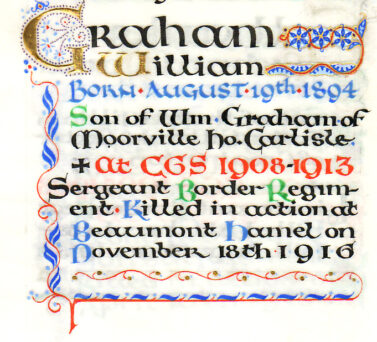William enlisted in Carlisle in the 11th Battalion the Border Regt., better known as the Lonsdales. The Lonsdale’s had been formed by the Earl of Lonsdale and it was a “pals battalion”. William was in B company which was made up of men from North and West Cumbria and landed in France on the 23rdNovember 1915.
He was a corporal but at the time of his death he was acting sergeant. On July 1 1916 the battalion were at Authuille WoodU, the War Diary states
“Zero time 7.30 am. Battalion advanced from assembly trenches at 8 am and came under very heavy machine gun fire suffering over 500 casualties.”
The following extract is taken from The Story of L/Cpl. John Bardgett, in www.border-regiment.co.uk
“At 8.30am, sixty minutes after zero hour, Colonel Machell gave the final order. John and the men of the Lonsdale Battalion made their advance from the edge of Authuille Wood. They were in relatively good spirits but all that was about to change. The men were by now expecting to be advancing towards a new British Front line across the entirety of the Leipzig Salient, yet this was sadly not the case. Only the redoubt had been taken and in hindsight the Lonsdales advance should not have been ordered. Divisional HQ already knew that the adjoining 8th Division to the south opposite Ovillers was unsuccessful in their attempts to take the other German strong point, the ‘Nord-Werk’. From this position, and although quite distant from their mark, the German soldier’s line of sight was clear across the Lonsdales path. Still, the order was given and the advance took place. Their route took them more or less along the track that runs towards Thiepval from Authuille Wood. Chequerbent Street(the old British front line) or Chowbent Street, the two communication trenches leading up to the British front line, would have given them the perfect cover to make their advance up to the ‘jumping off point’. Unfortunately, this was not possible as these trenches were already overwhelmed with dead and wounded soldiers; instead, the front line was reached through open ground. Anyone moving out of Authuille Wood was clearly seen by the German machine gunners manning their posts. This action proved to be fatal.
Moving out in formation German enfilading fire from the Nord-Werk caught the Lonsdales with a devastating force, killing and wounding many men before they managed to reach their own front line. Colonel H C Wylly author of ‘The Border Regiment in the Great War’ writes:
On leaving their trenches in the wood, even before arriving at the front British trench, the battalion came under terrific machine-gun fire—the shell fire was practically negligible while such musketry as came in it’s direction was too high. There was no question of flinching; the companies, men dropping every moment, moved steadily on, and, on leaving the advanced British trench, pushed on straight to their front for a time and then, as had been ordered, wheeled eastward. The attacking line, supported by the Lonsdales, was having a hard fight to try and reach the German trenches, but few were able to go so far since the enemy machine guns were taking a terrible toll, moving down the men in scores and causing very heavy losses.
It was a slaughter to which they stood little chance of survival. Those who did make it to the front line waited for their numbers to join them but most would not be coming as their bodies lay strewn on the open ground behind them”
William was unaccounted for when a roll call was taken the next day. And his death was assumed Nov 18 1916.
He is commemorated on the Thiepval Memorial. Pier 6A Face 7C.

